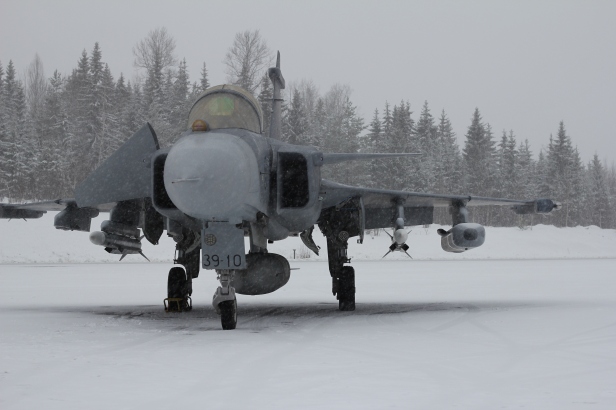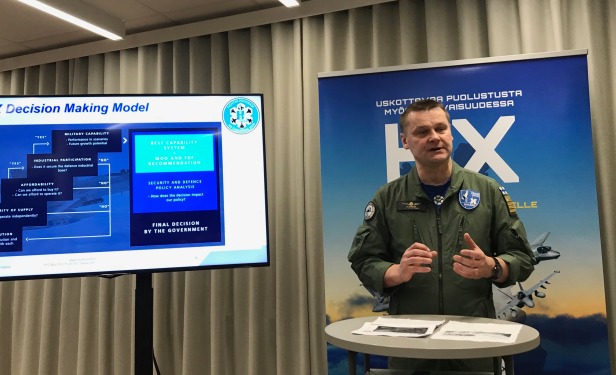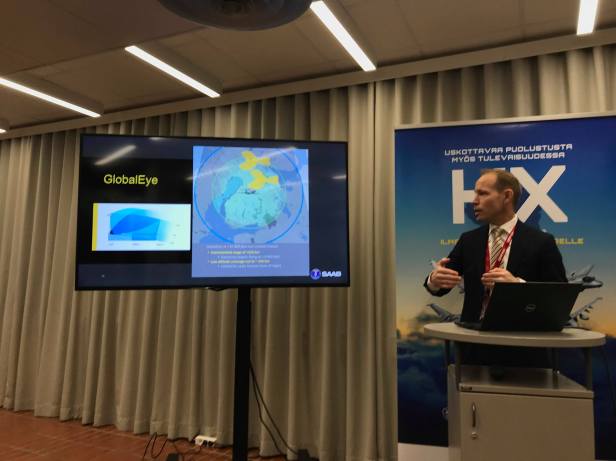The snow finally arrived to central Finland this week, and with it came the last eurocanard to take part in HX Challenge. 39-10, the latest of the pre-production JAS 39E Gripens, touched down on Tampere-Pirkkala airport in a landscape that looked decidedly different compared to the weeks before when the Eurofighter and the Rafale had been visiting.

Someone that didn’t show up was anyone working at the Swedish embassy in Helsinki, a marked difference from the media days of the other two eurocanards. The reason was simple: “I don’t think anyone doubts that Finland and Sweden has a close bilateral cooperation.” As such the focus was placed on the aircraft instead of the strategic partnership, though the offer was described as being prepared in close cooperation with both the Swedish Air Force and the Swedish Defence Materiel Administration (FMV). This is also crucial, as besides the limited Brazilian order Sweden is so far the only major buyer of the 39E-version. Any Finnish order will rest on how reliable the Swedish long-term (i.e. into the 2060’s) commitment to the 39E as a platform is judged to be.
Saab has decidedly taken the Air Force at their word when they said they want the best capability that can fit inside the budget, with an offer that include not only the 39E/F Gripen, but also the GlobalEye airborne early warning and control platform. As reported last summer the idea behind is that not only does it improve the overall combat capability of the Finnish Air Force, but it also saves the fighter fleet by off-loading part of the missions that would otherwise have been flown by the HX fighters. This not only saves money and airframes, but crucially helps in ensuring a high-level of readiness for the fighter fleet. Anders Carp, head of Saab’s Surveillance business unit explained that they are happy to be able to offer HX “a true force multiplier”, and that he expects the Finnish Air Force to be happy about it as well. Unfortunately, the poker faces of the FinAF colonels present held, so we have to wait until 2021 to see if that is a correct conclusion.

However, colonel Keränen in his briefing prior to Saab’s presentation did note that ISTAR is a capability that will be required from the HX-package, and that it is a new capability compared to the current Hornet-fleet. This is interesting in that it shows that the capability sought is something more than what the Hornet currently offer by flying around with their AN/APG-73 radars and Litening-targeting pods. Here the GlobalEye really shines, as it not only provides a superior air-to-air picture (especially against targets operating at low heights) compared to the current Finnish ground-based network, but also provide air-to-surface radar pictures and signal intelligence from passive sensors. The range of sensors, both passive EW-sensors and possible EO/IR-sensors, can be tailored towards the specifications of the customer. However, in general it could be noted that the aircraft would not only be a valuable sensor in wartime, but would provide a serious benefit in peacetime as well through its ability to gather information far beyond the Finnish borders. As such, it would complement the Air Force’s single C-295 SIGINT-aircraft and the Border Guards’ maritime patrol aircraft.

For the Gripen, much of the focus was on the adaptability and electronic warfare side of things. The differentiation of flight critical software, and to some extent hardware as well, from the mission software ensures that it can be upgraded in short increments, avoiding the traditional larger but less frequent MLUs. This is incremental upgrade approach is in effect already now with the current 39C/D-fleet, but the steps would take place in even shorter increments for the 39E/F. “This is unique”, according to Saab, who also pointed out that when the first 39E flew, it did so with a fully certified software. This is also exploited in the form of the 39-7 two-seat aircraft demonstrating the capabilities of the 39F for HX Challenge. The aircraft has a full set of 39E/F mission systems in the backseat, while the flight control software is based on that of the 39C/D.
When faced with the question of how the aircraft that currently is in the test and verification phase, Saab’s view was that since the aircraft is mature enough and will meet the Finnish deadlines with time to spare, it’s recent appearance on the market is simply a benefit. Being the newest of the contenders ensure that the technology is new, and allow the company to take advantage of the latest developments in a way older platforms can’t.
I guess you can make the arguement that the glass is half full.

For the electronic warfare side, according to Saab the aircraft is providing capabilities close to those of dedicated platforms (read: EA-18G Growler). It is “probably the most advanced EW-suite” carried by a fighter, and provide a full spherical coverage from all directions. This include not only missile approach warning systems, but also internal jammers, chaff/flare dispensers, and so forth. When that isn’t enough, the brand new Electronic Attack Jammer Pod (EAJP) can also be carried, a fully functioning version of which was carried by 39-10 in Tampere. At this point, Saab notes that the 39F does provide superior performance in the electronic warfare (and SEAD/DEAD) role, as the combined suite is powerful enough that to get out the maximum use of it a dedicated systems operator is needed.

- The EAJP is utilising some of the “same kind of technology” as found in the internal EW systems of 39E, but provide broader frequency ranges and more power when needed. Source: Own picture
While electronic warfare capabilities are difficult to judge based on open sources (we are basically left to trusting that the manufacturers don’t stretch the truth too much) one thing that Saab is sure to have in their favour is the solid presence on the ground in Finland. Saab already has a serious research and development unit in Tampere, the importance of which is set to grow in the coming years thanks to Saab receiving the contract for the combat management system of the Pohjanmaa-class. As such, they are well positioned to reach the stated 30% of contract value in industrial cooperation, the vast majority of which will be directed towards direct cooperation according to the company. The program is very ambitious, and in what is something of a surprise still include not only component manufacturing and final assembly of the aircraft, but of the engines as well. Granted most manufacturers stated that a domestic final assembly line was possible at the outset of the HX programme, but there has been relatively little talk of the topic since, and my impression has been that the interest towards the idea from both the manufacturers and Finnish industry have in fact been lukewarm.
Saab is of a different opinion, and stated that it is the best method of ensuring that Finland actually has the ability to overhaul and maintain the aircraft if the supply lines are cut (which is the requirement of the RFQ). Production of aircraft engines is something that hasn’t taken place in Finland for a long time, but Saab expressed confidence in that Patria’s Linnavuori plant is up to the job. Negotiations are currently ongoing regarding the details of the proposal, and the fact that the Hornet’s F404 engine (on which Patria does qualified maintenance) serve as the basis for the Gripen’s F414GE would probably aid in the transition.
Speaking of transitions, Saab stated that the Gripen would require only “minor adaptations” of the existing infrastructure, and that they foresee a “very smooth integration effort”. A key point was also that no additional noise pollution or environmental impact was expected relative to the legacy-Hornet fleet, an issue that has been highlighted as some other fighter acquisitions has created the need for expensive remodelling of air bases. Here one might note that colonel Keränen also provided some further details on the timeline for the transition. By 2025 the first deliveries are to take place, so that Finnish Air Force personnel can start training on the aircraft. This might take place abroad or in Finland, key point is that the training starts, because by late 2027 the IOC should be declared, with the first HX squadron replacing a Hornet squadron in early 2028. By 2030 the last Hornets leave Finnish service, and HX declare FOC. Notable here is that up until IOC, the training and operating costs of the HX will at least partly come from the 10 Bn Euro additional funding that is allocated for the acquisition. This is due to the fact that normal Hornet operations continue in parallel, and the funds for these will claim the Air Force’s daily operating budget.
But did it fly? No, it didn’t. Was there a perfectly reasonable explanation. Yes, there was.
39-10 didn’t leave Sweden for the first time ever just to impress Finnish (and international) media, but rather to run a verification program. As the Finnish Air Force has stated a number of times, this isn’t about cold weather tests, but verifying the numbers and capabilities provided by the manufacturers in a Finnish setting. The weather conditions did not match any of the planned verification sorties, so the aircraft stayed on the ground. GlobalEye on the other hand had suitable verification flights that could take place, so it appeared in the skies over southern Finland with a mixed Saab/Finnish Air Force crew aboard.
Being a mechanical engineer I saw nothing strange in this. In my earlier work I’ve been present when the weather has been either too good or too bad for planned sea trials. Then the boat stays in the harbour. Not because of the vessel in question isn’t able to go to sea, but because the only thing you would achieve by doing so is burn diesel and kill time. Granted it would have been nice to get to see the aircraft take-off today, but c’est la vie.
However, populists gonna populist. Self-proclaimed defender of Lapland (with friends like these…) Mikko Kärnä in a single tweet manages to 1) describe the purpose of HX Challenge incorrectly, 2) give false (or at least out of context) quote by Saab as to the reason for not flying, and 3) draw faulty conclusions based on those two incorrect statements. Unfortunately, the story about Gripen not being able to fly in snow will likely endure in some fringes of the Finnish political discussion. The influence long-term will likely be minor, but I can already feel how tiresome it will be to hear these talking points making rounds on social media and around coffee tables.
For those interested in whether the Gripen can fly in snow, just ask Antti Virolainen.


Thank you once again for a well written and balanced article, a joy to read
👍
The Swedish offer is really interesting and likely the best of the 4gen offers. The part about EW is especially interesting. I wonder how good their sensors are and sensor fusion are, as it has touted as being one of their strong points.
Saab has really taken FinAF’s word that they are not buying fighters, but capabilities…
I just wonder , to fit Globaleye(s) in the budget, how many Gripens they had to cut?
As was reported last year, they were able to fit the full 64 fighters in the original package (52 39E + 12 39F). That’s thanks to the offloading part, and flight hours on business jets being (relatively cheap). https://corporalfrisk.com/2019/06/15/globaleye-for-hx/
There was newspaper article on Turun sanomat 31.1, where Saab rep. had told that number of fighter had been cut because of the Globaleye.
Maybe journalist misunderstood something, or they offer more than 2 Globaleyes?
Cut maybe what 4-6 Gripens, offer total 3 Globaleyes?
Randomvisitor, I remember that phrase used was that GlobalEye of course effects the number of fighters that can be offered, but this is captain obvious and it offered no information of how many fighters will be offered. It could be anything from 60 to 68. Highest number asked in RFI was 72.
So press got something wrong, well that’s a shocker…
That is incorrect: -10 and -7 flew both Monday and Tuesday as part of aircraft evaluation activities.
But you were there – did you not see this?
If you look at the date the post was published, it was Thursday 30 January when the media event had taken place. By that time 39-7 hadn’t arrived and 39-10 hadn’t flown evaluations yet.
OK, maybe update the piece to reflect this? 🙂
To be honest I don’t see a need for that. The post was written after the media event and accurately notes that the aircraft didn’t fly during that day as opposed to the Rafale and Eurofighter. I also note that I don’t see anything strange with that and that the evaluation will likely continue according to expectations, which it also did.
Oh well, you know best. Most sites add an update and since you appeared irritated with this Karna fellow, it might have been worth adding that both Gripen flew – just not at the particular time of your post.
Otherwise, the inference might be that they did not fly at all.
Agree w/ Blue 5 re possible wrong inference that the Gripens didn’t fly at all vs just not on the 1st/ press day.
hi Corporal Frisk, first i must say its a good blog and interesting to read.
Then I wonder about the long term commitment. Dont SAAB have quite good record with draken that was used for a long time in Finland and Switzerland. Seems to be on the lower limit of keep upgrading going since it’s about 200 C/D and 100 E/F (with finland 164) and it is likely they sell more even though we cant calculate with the big sells as India or similar.
If I remembered right someone here said something like:
– F-35 is a more mature plane!
Please read this.
– Despite the triumphant 2018 proclamations that the program had completed its troubled development process, the testing office has reported that development “may take years to complete.” Meanwhile, F-35 pilots today are dealing with the effects that “may be observed from both operational testing and fielded operations.”
Source: https://www.defense-aerospace.com/articles-view/feature/5/209996/f_35-design-flaws-mounting%2C-new-document-shows.html